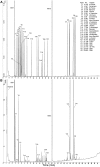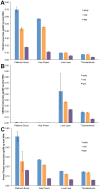Accumulation of bioactive metabolites in cultivated medical Cannabis
- PMID: 30036388
- PMCID: PMC6056047
- DOI: 10.1371/journal.pone.0201119
Accumulation of bioactive metabolites in cultivated medical Cannabis
Abstract
There has been an increased use of medical Cannabis in the United States of America as more states legalize its use. Complete chemical analyses of this material can vary considerably between producers and is often not fully provided to consumers. As phytochemists in a state with legal medical Cannabis we sought to characterize the accumulation of phytochemicals in material grown by licensed commercial producers. We report the development of a simple extraction and analysis method, amenable to use by commercial laboratories for the detection and quantification of both cannabinoids and terpenoids. Through analysis of developing flowers on plants, we can identify sources of variability of floral metabolites due to flower maturity and position on the plant. The terpenoid composition varied by accession and was used to cluster cannabis strains into specific types. Inclusion of terpenoids with cannabinoids in the analysis of medical cannabis should be encouraged, as both of these classes of compounds could play a role in the beneficial medical effects of different cannabis strains.
Conflict of interest statement
This work was possible because research scientists employed at a public university collaborated with two licensed medical marijuana industry members in NM: Rio Grande Analytics and Ultra Health. These commercial entities did not play a role in the study design, data collection and analysis, decision to publish, or preparation of the manuscript; they provided no financial support for supplies or salaries. They did provide analysis space and access to medical marijuana plants during their growth cycles. This does not alter our adherence to PLOS ONE policies on sharing data.
Figures








References
Publication types
MeSH terms
Substances
LinkOut - more resources
Full Text Sources
Other Literature Sources
Medical
Research Materials

